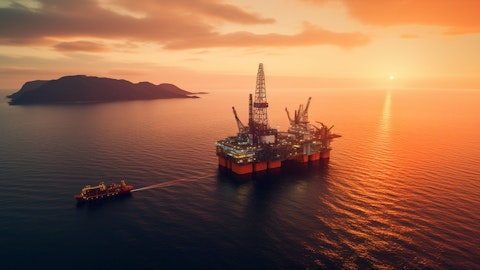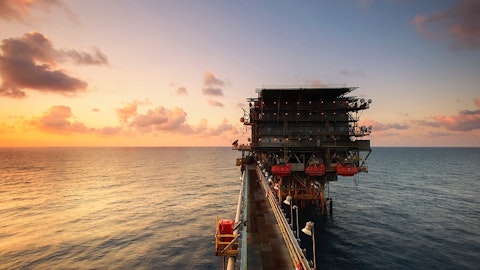And so within the drilling world, pleased to be celebrated by one of the major Middle Eastern national oil companies, as I mentioned, for streaming data from 100 rigs at a much higher rate than their previous service provider. In the completion space, our Max Completion is gaining a lot of interest amongst pressure pumpers and their customers in enabling more optimization of frac jobs. We’re also continuing to improve that product. And so 3,500 — more than 3,500 users now, and it’s growing pretty dramatically. And then there are several other areas where we’re using that in conjunction with artificial intelligence to drive better results. So, our KAIZEN drilling optimization program, our new drilling beliefs and analytics, which has been, as — I think I mentioned in my prepared remarks was adopted by a couple of large independents shortly after our introduction just a couple of months ago.
And so really pleased with how all of this is going.
Jim Rollyson: Yes. Understood. Sounds exciting.
Clay Williams: Thanks Jim.
Operator: Thank you. And our next question is going to come from the line of Ati Modak with Goldman Sachs. Your line is open, please go ahead.
Ati Modak: Hi, good morning guys.
Clay Williams: Good morning.
Ati Modak: You mentioned some divestiture plans. Can we get some more color on what the size of those proceeds could look like? And how should we think about the nature of those asset sales?
Clay Williams: We prefer not to disclose anything more, other than we think this is prudent. We think this is prudent stewardship of our capital and see an opportunity to reposition, adding a product line and then capitalizing on the fact that others value another product line more highly than us. And so I’m kind of just going to leave it at that.
Ati Modak: Okay, got it. And then you provided a range for your revenue growth for the full year. Can you help us understand the drivers of the low and high end there and the subsequent impact on EBITDA? How should we think about the drivers?
Jose Bayardo: Yes. Ati, it’s Jose. Yes, really, the way that we’re looking at it, provide the guidance by sort of major region, North America versus international. And just to repeat it because I know it’s hard to catch everything during the course of the call. We said low to mid-single-digit percent range for North America and for international markets, low double-digits. And so those are percentages that I would apply generally across the segments to sort of get to a notional range of where we think the revenues will be for each of the three segments. And basically, those ranges are a little bit more optimistic than what we expect will occur in the marketplace from an E&P CapEx standpoint. So, what we’re generally saying is that we think we will continue to outpace the rate of global spend due to all the things that Clay highlighted related to the technology innovation that’s continuing to gain more and more traction out there and the positioning that we have, frankly, in the higher growth regions of the world.
I also said that the EBITDA flow through, we expect to be in the mid-30% range. So, a step up from kind of where we have been. As we continue to get a better quality of mix in our backlog, better pricing and also some of the cost save — the effects of cost savings that we’ve been working diligently to push through the system. So, that’s sort of it in a nutshell.
Ati Modak: Thank you. I’ll turn it over.
Clay Williams: Thanks Ati.
Operator: Thank you. And our next question is going to come from the line of Doug Becker with Capital One. Your line is open, please go ahead.
Doug Becker: Thanks. I didn’t catch any update on the cost-out program, the $75 million. Just — any update on how that played into the fourth quarter and expectations as we go through this year?
Jose Bayardo: Yes, Doug. Yes, as you heard in the commentary, and I think in the press release as well, the major initial catalyst for our cost savings program is really the — we start with the voluntary early retirement program and also the restructuring of the segment structure. So, going from the three segments down to the two segments. So, all of that really just happened and just got underway. So, very minimal impact from our cost savings efforts through Q4. Expect a little bit in Q1, but really expect to see that gain steam during the remainder of 2024.
Clay Williams: Another piece of that, too, is the closure of facilities. So, we just closed a couple of facilities in South America and Europe as well. And so those savings will be flowing in a little — midyear or so.
Doug Becker: Got it. And no change to the $75 million?
Clay Williams: No, I think we’re on track for that.
Doug Becker: Got it. And then, Clay, you mentioned still expect growth in Saudi Arabia. Just trying to get any context here, have your internal expectations changed given the renewed — and then just how do you think about 2025 or 2026, if you end up having fewer jack-ups working offshore Saudi Arabia?
Clay Williams: Yes, it’s a good question. Let me caveat my answer by saying I don’t — certainly don’t want to speak on behalf of our good customer, Aramco, and I think we’ll be seeing more about this in coming weeks. With that caveat, what we think — and I’ll be there a week after next in the Kingdom. What we think they are referring to is really around probably the FID of Safinaya, which is a very large offshore field development that they have not yet FID’d. It’s north of $20 billion. And so it doesn’t really impact 2024. With respect to 2025 and 2026, I think even without Safinaya, the Kingdom would continue to grow revenues because they continue to press ahead with development drilling to offset declines of conventional oil wells to add production to existing offshore fields that they’ve already FID’d to add gas production, which is a critical strategic priority for the Kingdom to support domestic gas production and move forward with their unconventional Jafurah development.
And so that all adds up to be, I think, a region that is going to continue to grow for the next few years, probably several years in the absence of one or two large offshore fields that get postponed a bit. So, we’re still very bullish on the outlook for the Kingdom. And in fact, just yesterday, won an award for a nonmetallic liner — lined steel tubing business for our Tuboscope plant there in the Kingdom. And really across our portfolio, foresee continued activity supporting all that other work that’s going on there. With respect to the jack-ups, just to level set for everybody, they’ve dramatically grown their jack-up drilling fleet going from about 50 rigs on up to I think about 78 or 80 or so are turning to the right, and then there’s another dozen or so that are under contract to come online.
So, you add all that up, it’s about 91 jack-ups, up from about 50 not long ago. So, a big, big step-up in drilling activity. Those are new contracts. Good rigs. We’re working efficiently. I don’t know precisely what their announcement — how it might impact that. But at this point, we’re all kind of speculating. But nevertheless, we continue to support all those rigs and continue to remain active on some that are contracted that we’re reactivating to put into that market.
Doug Becker: Thank you very much.
Clay Williams: Thanks Doug.
Jose Bayardo: Thanks Doug.
Operator: Thank you. Our next question is going to come from the line of Kurt Hallead with Benchmark. Your line is open, please go ahead.



